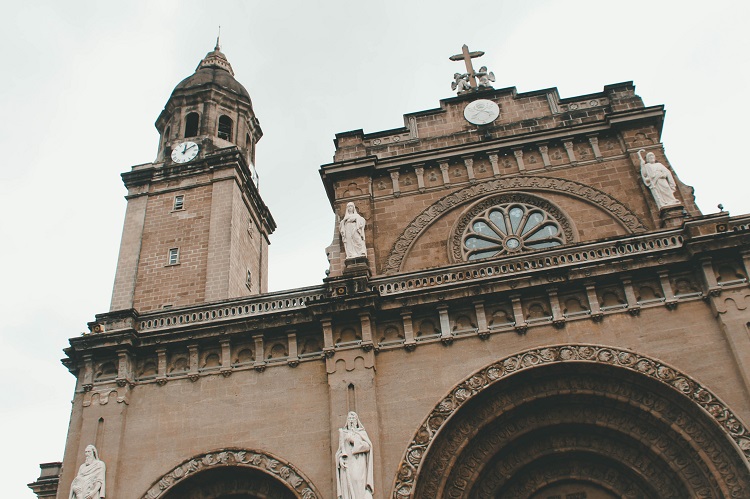The conflict between Padre Damaso and Ibarra finally comes to a head. In a fit of rage, we see Ibarra take matters into his own hands, all the while delivering the most moving speech in the book in my opinion.

Chapter 31: The Sermon
Padre Damaso delivers the first half of his sermon in Spanish, extolling the virtues of Saint Diego in such high-sounding words, and in such a bombastic and circuitous manner, that the indios[1] are doubly unable to understand anything. They mistake his pronouncements as pertaining to their earthly affairs.
Damaso then improvises the second part of his sermon in Tagalog, and castigates his listeners in general terms, raging against the people’s lack of reverence for religion and priests. He takes an indirect swipe at Ibarra by talking of unconfessed sinners dying in prison, an unnamed reference to Ibarra’s father, and puffed up half-breeds, an allusion to Ibarra.
The friar goes on preaching for such a long time, his listeners begin to doze off or daydream. When Damaso’s sermon finally ends and the mass continues, Ibarra hears Elias whisper in his ear, warning him not to go down the trench at the laying of his school’s cornerstone.
Chapter 32: The Derrick
Ñor Juan looks with admiration at the complicated derrick an unnamed individual he had commissioned for it had set up. The hired man says it was his father who taught him mechanics, who in turn was taught by Don Saturnino, Crisostomo’s grandfather. The man relates in his story that Don Saturnino was cruel to his workers.
Important personages soon gather to witness the lowering of the school’s cornerstone. Guests include the alcalde[2], municipal officials and the friars. Elias, masked by his salakot[3] and rough clothes, is there too.
The ceremony commences with Padre Salvi blessing the site. Each important guest then goes down the trench to ceremoniously lay a bit of mortar. As Ibarra takes his turn, the entire contraption collapses, and though shaken, he escapes unscathed. Found in the trench however, is the dead body of the man who had built the derrick.
Chapter 33: Free Thought
Ibarra rushes home to change his clothes where he is followed by Elias, who warns him of enemies, both from the very poor and from the rich and powerful. Among these is the man who had built the derrick, who, as it turns out, had died as a result of Elias putting him in harm’s way as the derrick collapsed.
The conversation between the two men reveal a little more about Elias’ character. He has had to believe in a deliberate God because he has lost faith in man, and rejects the kind of justice corrupted by man.
Chapter 34: The Dinner
Despite the recent death at the site, the celebratory meal proceeds as planned. Capitan Tiago leaves early as he receives a telegram informing him that the Captain-General will be arriving at his house. The friars feel slighted that the official will not be staying at the convento.
Padre Damaso arrives late at the table and proceeds to insult Ibarra by declaring the stupidity of hiring experts when all that is necessary in building a schoolhouse is common sense and cheap labor. He also disparages self-important young indios, over whom God’s justice is meted out, as their fathers are punished by dying in jail. Angered by this indirect reference to his father, Ibarra hits Damaso and brandishes a knife over him.
Ibarra launches into an impassioned speech, declaring how his father had been a good man, and how Damaso had repaid his friendship with persecution. Ibarra asks the onlookers to recall how he had held his peace even as he himself became the object of Damaso’s persecution.
As Ibarra raises the knife, Maria Clara puts herself between him and Damaso. Ibarra drops the knife and flees.
Chapter 35: Comments
News of what occurred between Ibarra and Damaso spreads across town and people offer varying and divided opinions. The gobernadorcillo wishes Ibarra had been more prudent. Don Filipo argues that between the two, it was Ibarra who had been the more mature. Capitan Martin thinks Ibarra will never be forgiven. Among the women, Capitana Maria lauds Ibarra for defending his father’s memory and honor, while Sister Rufa maintains that it is a sin to raise one’s hand against a priest.
The most disheartening observation comes from a parent of one of the school’s would-be pupils. He is certain that there would no longer be a school, for the priests had called Ibarra a filibustero[4] whose fate is death.
Notes and References:
1. A term used by the Spaniards to refer to the native occupants of the Philippine islands. Ambeth R. Ocampo, Bones of Contention: The Bonifacio Lectures (New Edition), (Mandaluyong: Anvil Publishing, Inc., 2014), 102.
2. An alcalde mayor was a provincial governor. Luis H. Francia, A History of the Philippines: From Indios Bravos to Filipinos, (New York: The Overlook Press, Peter Mayer Publishers, Inc., 2010), 338. In today’s usage, ‘alcalde‘ in the Philippines is translated as ‘mayor’.
3. A traditional wide-brimmed hat.
4. According to the translator, this is someone who incites public rebellion or dissent. Jose Rizal, Noli Me Tangere, Critical Edition by Isaac Donoso Jimenez, (Quezon City: Vibal Foundation, 2011), 726.
Recent Comments